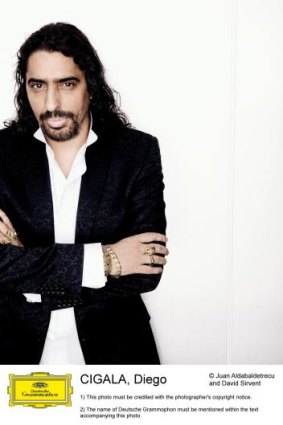By John Shand
Diego El Cigala has a secret. It’s a secret that every singer needs to know, but only a handful in each generation discover. It puts him in rarefied company with Billie Holiday, Frank Sinatra and Giuseppe Di Stefano, making him one of the great singers of the past 100 years. The secret? How to convey emotion without becoming sentimental; how to sing with the raw truth of an open wound. .
El Cigala’s earthy, nicotine-stained voice can burn with a similar blue flame to Holiday’s, manipulate heart-strings like that great marionettist Di Stefano and, like Sinatra, successfully emote without becoming effete. It is about feeling rather than faking.

Diego el Cigala
Truth is certainly the core of El Cigala’s music of choice, flamenco, with its imperious dances, dramatic guitar and anguished songs. Asked when he fell in love with it he replies, “I think in my mother’s womb!” and laughs, but he is only partly joking. Both his parents were flamenco singers, and if we do absorb anything more than nutrients in the womb then chances are that the embryonic Diego was a sponge for flamenco’s rhythms, melodies and passions – for its “heart and soul”, a phrase that becomes almost a mantra during our conversation.
When we speak (via an interpreter) El Cigala is at home amid th e palm trees of the Dominican Republic, where he lives with his wife (who doubles as his manager) and two sons. He moved there from Madrid once the Americas became the centrepiece of his touring schedule, and believes that the worldwide surge of interest in flamenco is partly explained because, like Italian opera, it suffers from no language barrier. “It’s so much sung from the heart and from the soul that all over the world everybody’s listening to it,” he says. “Even though they don’t understand it they feel the music and they feel flamenco.”
Whether or not El Cigala had already felt it in his mother’s uterine comfort zone, he certainly did when he hit the real world. This was in 1968, and Diego Ramon Jimenez Salazar – his El Cigala nickname means “Norway Lobster” (a popular seafood) – was constantly surrounded by flamenco singing not just from his parents, but from their relatives and friends “on the patio singing and just doing flamenco always”.
Initially his exceptional rhythmic sense saw him employed to clap out the music’s intricate compas (beats) for established luminaries; he steeped himself in the idiom for fully three decades before recording his first solo album in 1998. Subsequently he has carved out his own niche, partly via collaborations with stars of Cuban music and Argentinean tango.
Asked why flamenco can adapt and blend so readily, El Cigala initially repeats the heart-and-soul mantra, then explains that ultimately he attributes this to its “rhythmic richness”. On the other hand he says that flamenco is also “very basic”. “You need a guitar and you need a good voice, and then you need to have your feelings. From the moment I go on the stage I always put my heart and soul into singing, and I want my audience to feel that and feel the same things that I’m feeling when I’m singing."
The point of his collaborations, he says, is to find common roots between flamenco and other idioms. “It’s not about me deciding to mix different kinds of music,” he says, “but me finding points in common and working from there. Me and [the late Cuban master pianist] Bebo [Valdes] used to say that our music was like cousins getting back together after a long time without seeing each other!”
While El Cigala’s commitment to flamenco is such that he sees it as a way of life, he nonetheless listens widely, and such potent opera singers as Luciano Pavarotti and Maria Callas have been major influences. “I’m also very much in love with music from Latin America because it’s very rhythmic. It’s got a nice feeling like flamenco. I like very much Ray Charles, Michael Jackson, Stevie Wonder. I love a variety of music.”
For his first Australian tour his band consists of two guitars, piano, bass and percussion, and the material will wander from what he calls “raw flamenco” to the lush music of his collaborative projects. “I always support traditions, but if something does not evolve it is not alive, and therefore won’t survive. The important thing is not to forget your roots.”
In his case they were planted in the womb.
Diego El Cigala is at the State Theatre on August 25.